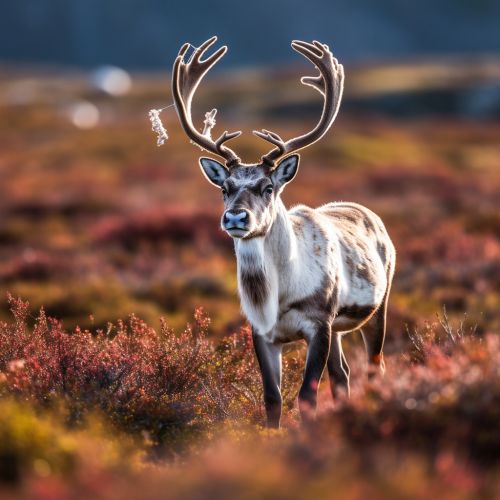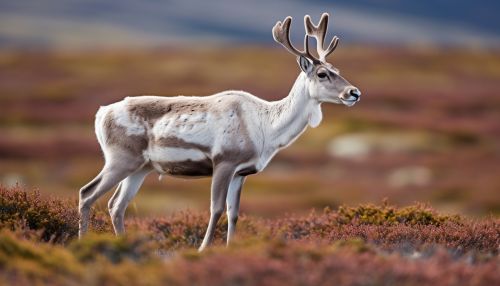Caribou
Taxonomy and Evolution
The Caribou (Rangifer tarandus), also known as the reindeer in Europe, is a species of deer native to arctic, subarctic, tundra, boreal, and mountainous regions of northern North America, Siberia, and Europe. This species is part of the larger deer family (Cervidae), which also includes species such as the moose, elk, and white-tailed deer.
The caribou is further divided into several subspecies, based on differences in size, coloration, and habitat preference. These include the barren-ground caribou (Rangifer tarandus groenlandicus), the woodland caribou (Rangifer tarandus caribou), and the Peary caribou (Rangifer tarandus pearyi), among others.


Physical Characteristics
Caribou are notable for their large size, with males typically weighing between 350 and 400 kilograms, and females weighing between 180 and 215 kilograms. They possess a thick coat of fur, which is primarily brown in color, but can range from nearly white in the Peary caribou to almost black in woodland caribou.
One of the most distinctive features of the caribou is its antlers, which are the largest relative to body size among all deer species. Both males and females grow antlers, although they are typically larger and more branched in males. The antlers are used in mating displays and in fights for dominance during the breeding season.
Habitat and Distribution
Caribou inhabit a wide range of habitats, from the tundra and boreal forests of Canada and Alaska, to the mountainous regions of Scandinavia and Russia. They are well-adapted to these harsh environments, with specialized hooves that allow them to traverse snowy and rocky terrain, and a diet that includes lichens and other hardy vegetation.
Despite their wide distribution, caribou populations have been in decline in many areas due to factors such as habitat loss, climate change, and overhunting. Conservation efforts are underway to protect and restore these iconic animals and their habitats.
Behavior and Ecology
Caribou are highly social animals, often forming large herds that can number in the thousands. They are also migratory, undertaking long-distance seasonal migrations that are among the longest of any terrestrial mammal.
During the summer months, caribou feed on a variety of plants, including grasses, sedges, and leaves. In the winter, they rely heavily on lichens, which they are able to dig up from beneath the snow using their large hooves.
Caribou are preyed upon by a variety of predators, including wolves (Canis lupus), bears (Ursus arctos), and humans. They have developed several strategies to avoid predation, including forming large herds and migrating to areas with less predator pressure.
Cultural Significance
Caribou have long held a central role in the culture and livelihoods of many indigenous peoples of the Arctic and Subarctic regions. They are hunted for their meat, hides, and antlers, and are also used as draught animals in some cultures.
In addition, caribou feature prominently in the mythology and folklore of many northern cultures. They are often associated with themes of travel and migration, reflecting their own migratory behavior.
